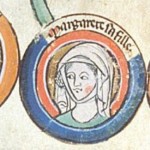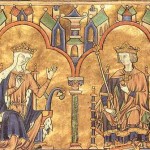Tag: Marguerite of Provence
A Game of “10 Questions” with Kayla at the Pittsburgh Historical Fiction Examiner
I am happy to be back at the Pittsburgh Historical Fiction Examiner today as part of Kayla’s “10 Question” series. So, if you’ve ever had a pressing desire to know which five people from history I’d like to host at a dinner party, or what I drink when writing (no – not cocktails), now is your chance to find out.
Or, if you are interested in learning more about the inspiration for my debut novel, The Sister Queens, and the amazing women at my story’s heart (Marguerite and Eleanor of Provence), I did this earlier interview at The Examiner on those topics.
On This Day in Her Story #8: A Reunion of The Sister Queens
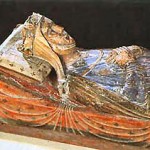
In October of 1254 Henry III and Eleanor of Provence receive permission from Louis IX of France to travel through his kingdom while making their way back to England from Gascony.
King Henry is eager to visit the grave of his mother, Isabella of Angoulême, at Fontevrault Abbey. Eleanor is excited by the prospect of seeing her sister Marguerite (Queen of France) after nearly two decades of separation. The stage is set for a family reunion between Provencal sisters and a meeting of their royal husbands during the Christmas season.
On This Day in Her Story #7: A Namesake for Marguerite of Provence
On This Day in Her Story #6: The French Royals In The Kingdom of Cyprus
Mid September 1248 – The French crusaders land in the Kingdom of Cyprus where they will winter before continuing on to the Holy Land. King Louis IX; his queen, Marguerite of Provence; his brothers Robert and Charles and their wives all arrive on the same ship. Pulling into port they are greeted by an overwhelming and very reassuring sight—vast quantities of supplies for their crusade. These stores are tangible proof of the efficacy of Louis’s hard work and planning in the years before they left France. 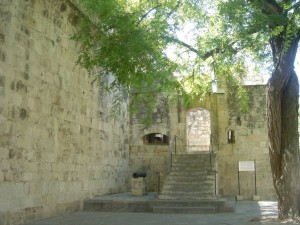
On This Day In Her Story #5: Crusade!
On This Day In Her Story #4: The Death of Raymond Berenger
August 19th 1245 – Marguerite and Eleanor’s father, Raymond Berenger, Count of Provence dies and their sister Beatrice inherits Provence. Because Raymond dies in the midst of a massive power struggle between Pope Innocent IV and Holy Roman Emperor Frederick II, the question of succession inProvence takes on an international dimension and competition to lay claim to Beatrice’s hand is fierce.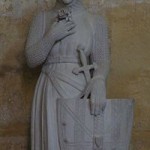
Invention is the Midwife of Good Historical Fiction
Necessity may be the mother of invention, but invention is the midwife of good historical fiction.
Invention and creativity are good things. But in historical fiction we (writers) sometimes lose sight of that, and get bogged down in the minutiae of our period and the thousand little details in our characters’ lives. I was recently reminded, with force, that readers come to authors of historical fiction for something more than a collection of facts.
I had the opportunity to hear Susan Vreeland, a master of the genre, speak at a recent Historical Novel Society Conference. I thought Susan was going to do a presentation on her latest book. But, when we were gathered before her in our neat little rows, she decided to tackle a larger issue – the role of invention in historical fiction.
“Don’t be tyrannized by fact.” That’s how Susan opened her presentation. And she is right of course. Historical fiction is not academic history. Does accuracy matter in historical novels? You bet your farthingale it does but, “fictional art can show truth that goes deeper than a collection of fact; it can show us what it felt like to be a particular person at a particular time” (again, Susan V). Besides, “as soon as something happens people start lying about it” (Cecelia Holland) so “truth” in history can legitimately be debated.
Susan pointed out that selection (and correspondingly, elimination) of facts is part of the process of writing compelling historical fiction. Good authors know instinctively – whether they write historical fiction or another genre – that telling just the right bits is what gives a great story its focus. Authors of historical novels must choose only those events from history that relate to the specific premise/themes of their particular novel. It doesn’t matter how interesting an event is (or how pivotal it is in the life of a historical character), if that event doesn’t forward the plot of the book an author is writing, then it needs to be left out. There were dozens of interesting events in the lives of my main characters, Marguerite and Eleanor of Provence, during the twenty-year period covered by The Sister Queens that did not make it into my novel because they were not germane to the “sisters” theme of my book. Continue reading Invention is the Midwife of Good Historical Fiction
On This Day In Her Story
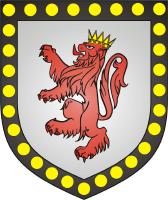 Today I am inaugurating a new series here at blog-central called “This Day In Her Story.” I will use it to feature historical tidbits that are germane to the stories of my sisters Marguerite and Eleanor of Provence. Enjoy!
Today I am inaugurating a new series here at blog-central called “This Day In Her Story.” I will use it to feature historical tidbits that are germane to the stories of my sisters Marguerite and Eleanor of Provence. Enjoy!
On This Day In Herstory #1
July 17th 1242 – The marriage contract between Henry III’s brother Richard, Earl of Cornwall, and Eleanor’s sister Sanchia is concluded. Talk about keeping it all in the family 🙂
Why Our Sisters are NOT Ourselves
Some things stick with you.
Last fall I heard this piece on NPR about breakthroughs in sibling research. It has been with me ever since—rumbling around in my brain.
This is the quote that got me:
Physically, siblings tended to differ somewhat, but they were a lot more similar on average when compared to children picked at random from the population. That’s also true of cognitive abilities.
“The surprise,” . . . “is when you turn to personality.”
Turns out that on tests that measure personality — stuff like how extroverted you are, how conscientious — siblings are practically like strangers.
“Practically like strangers” yet raised together. I’ve certainly had moments when I’ve thought how can my sister and I have had such a different experience of the same childhood or how could we have played the same games (together), walked to the same school (together) and heard the same family stories and yet turned out so very differently? If you have a sibling chances are you’ve had such thoughts as well. At the heart of my questions lay the idea that nurture shapes people, and since my sister and I were raised in the same environment that should have made us similar.
Turns out that’s just dead wrong when it comes to siblings. Being raised in the same environment helps to make us different. The three theories posited in the radio report sounded eerily familiar—though, as an author not a scientific researcher, I’d given them different names while writing The Sister Queens.
